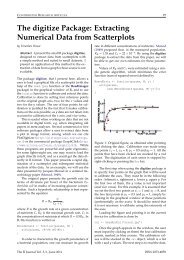prueba
probando yumpu
probando yumpu
You also want an ePaper? Increase the reach of your titles
YUMPU automatically turns print PDFs into web optimized ePapers that Google loves.
16<br />
(NDVI; Pettorelli et al. 2005a). The NDVI, computed as<br />
(NIR-Red)/(NIR + Red) where NIR and Red are the<br />
amount of near-infrared and red light, respectively,<br />
reflected by a surface and measured by satellite sensors,<br />
was first reported by Rouse et al. (1974). The latter<br />
study primarily dealt with the transformed vegetation<br />
index (TVI) and contained no references to<br />
previous work using ratios of NIR/Red, such as Birth &<br />
McVey (1968), Jordan (1969), and Pearson & Miller<br />
(1972). Subsequently, Tucker (1977, 1979) and Deering<br />
(1978) employed the NDVI to estimate herbaceous biomass<br />
and Tucker et al. (1981) showed how frequent<br />
NDVI measurements were highly correlated to herbaceous<br />
total dry matter accumulation over the period of<br />
observation.<br />
Green leaves absorb incoming solar radiation in the<br />
photosynthetically active radiation spectral region,<br />
which provides energy needed to power photosynthesis<br />
(Jensen 2007). More specifically, green leaves absorb<br />
incident solar radiation very strongly in the blue<br />
and red spectral regions and not as strongly in the<br />
green spectral region. In the near infrared spectral<br />
region, green leaves are highly reflective and no<br />
absorption occurs (Knipling 1970, Jensen 2007). Thus,<br />
green leaves have high visible light absorption<br />
together with high near-infrared reflectance, resulting<br />
in positive NDVI values. Bare soil, cloud, snow, and<br />
concrete have NDVI values close to zero, while water<br />
has negative NDVI values (Neigh et al. 2008). The<br />
NDVI has been shown to be highly correlated with<br />
photosynthetically active radiation absorbed by the<br />
plant canopy, photosynthetic capacity, net primary<br />
production, leaf area index (LAI), fraction of absorbed<br />
photosynthetically active radiation, carbon assimilation<br />
and evapotranspiration (Myneni et al. 1995, Buermann<br />
et al. 2002, Hicke et al. 2002, Wang et al. 2005).<br />
NDVI thus allows monitoring of vegetation photosynthesis<br />
through time and enables easy temporal and<br />
spatial comparisons (Myneni et al. 1997). It can be used<br />
to map, assess or predict the occurrence and impact of<br />
disturbances such as drought, fire, flood and frost (Pettorelli<br />
et al. 2005a), as well as helping to map and predict<br />
the extent of land degradation (Prince et al. 2009).<br />
In 2005, Pettorelli et al. (2005a) provided an overview<br />
of the use of NDVI in wildlife management,<br />
highlighting how NDVI-based indices could be linked<br />
to animal distribution and abundance. The applications<br />
of the NDVI in ecology have continued to increase<br />
and expand, with new uses and advances arising every<br />
year (Table 1). This is illustrated by the number of ecological<br />
articles published over the last 5 years which<br />
refer to NDVI (282 articles published in 2005 or later<br />
with the topic NDVI and subject area ecology counted;<br />
ISI Web of Science search, 23rd of August 2010). This<br />
popularity can be partially explained by NDVI being a<br />
Clim Res 46: 15–27, 2011<br />
widely available index with pre-processed NDVI data<br />
readily available from as early as 1981, and at various<br />
spatial scales. In comparison, access to pre-existing<br />
processed data for other vegetation indices at such<br />
temporal and spatial scales is reduced, and therefore<br />
presents a threshold for ecological studies in general<br />
(Pettorelli et al. 2005a). With this review we aim to<br />
update the overview provided in 2005 to acknowledge<br />
the great spectrum of possibilities associated with<br />
NDVI.<br />
2. SUCCESS OF THE NDVI IN WILDLIFE<br />
MANAGEMENT<br />
Much knowledge has been gained from coupling<br />
primary productivity distribution (as assessed by the<br />
NDVI) with species distribution and abundance (for<br />
recent examples, see Bro-Jørgensen et al. 2008, Evans<br />
et al. 2008, Pettorelli et al. 2009, St-Louis et al. 2009),<br />
but the greatest benefit of the NDVI comes from the<br />
access to large-scale primary production dynamics<br />
over time. Since NDVI also provides information on<br />
phenology (Fig. 1), it can be used to assess temporal<br />
aspects of vegetation development and quality (Pettorelli<br />
et al. 2007, Hamel et al. 2009). Such information<br />
has been shown to correlate with behaviour and life<br />
history traits of several species: in Norway, NDVI at<br />
vegetation onset was shown to be a strong predictor<br />
of red deer Cervus elaphus altitudinal migration date<br />
(Pettorelli et al. 2005b), while NDVI-based estimates of<br />
vegetation growth also proved to be helpful in understanding<br />
wildebeest Connochaetes taurinus migration<br />
in the Serengeti (Boone et al. 2006). In southern Africa,<br />
wet-season home-range sizes in elephants Loxodonta<br />
africana was shown to correlate with seasonal vegetation<br />
productivity as estimated by NDVI, while dryseason<br />
home-range sizes were best explained by<br />
heterogeneity in the distribution of vegetation productivity<br />
(Young et al. 2009). NDVI variation was also<br />
shown to correlate with elephant diet in Kenya (Wittemyer<br />
et al. 2009), while in Norway and France, NDVI<br />
in spring was shown to be a strong predictor of body<br />
mass in reindeer Rangifer tarandus and roe deer<br />
Capreolus capreolus (Pettorelli et al. 2005c, Pettorelli<br />
et al. 2006; see also Table 2).<br />
A demonstration of using the phenological signal in<br />
NDVI to understand the dynamics of an animal population<br />
is provided by Ryan (2006) and Ryan et al.<br />
(2007). In their 2007 study, the authors explored<br />
the relationship between seasonal NDVI patterns and<br />
birthing occurrence and synchrony for African buffalo<br />
Syncerus caffer living in a savanna environment.<br />
As the driver of this system appeared to be not simply<br />
the quantity of vegetation biomass, but rather the



